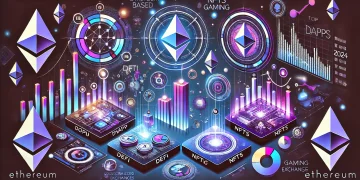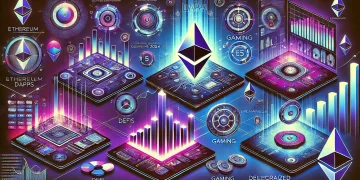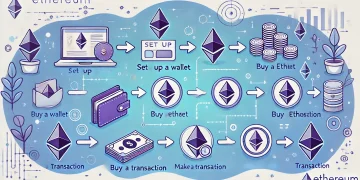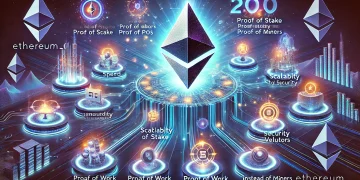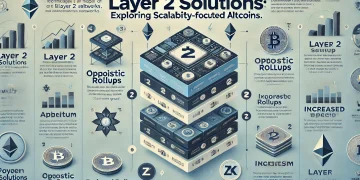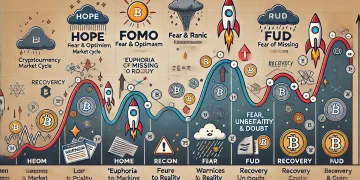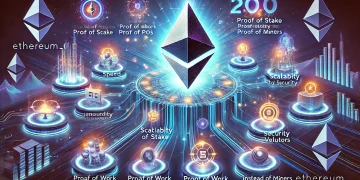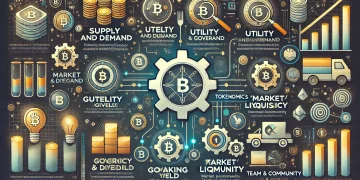As cryptocurrencies like Bitcoin and Ethereum gain popularity, the limitations of their blockchains become more evident. High fees and slow transaction speeds have plagued these networks, especially during periods of peak activity. This is where Layer 2 (L2) solutions come in. Layer 2 technologies are built on top of existing blockchains to enhance scalability, reduce congestion, and lower transaction costs. In this guide, we’ll explore scalability-focused altcoins and Layer 2 solutions, their role in improving blockchain performance, and how they are shaping the future of decentralized finance (DeFi).
What Are Layer 2 Solutions?
Layer 2 refers to off-chain solutions or protocols that run on top of an underlying blockchain (Layer 1) to improve its scalability and efficiency. These solutions reduce the burden on the main blockchain by processing transactions off-chain while maintaining the same level of security.
- Layer 1: The core blockchain network (e.g., Bitcoin, Ethereum).
- Layer 2: Networks or protocols that enhance the base blockchain’s capabilities without altering its core structure.
Examples include Lightning Network for Bitcoin and rollups for Ethereum. Layer 2 technologies aim to address common issues like high fees, slow speeds, and scalability bottlenecks.
Why Are Layer 2 Solutions Important?
As blockchain networks grow, the number of users and transactions increases dramatically, leading to congestion and higher fees. Ethereum, for instance, has seen transaction fees (gas fees) surge during periods of heavy usage, pricing out small users.
Layer 2 solutions are essential because they:
- Enhance scalability by processing transactions off-chain.
- Reduce fees for users by easing the burden on Layer 1 blockchains.
- Improve transaction speeds to support mass adoption.
- Enable DeFi and NFTs to thrive without network bottlenecks.
These innovations are paving the way for cryptocurrencies to support mainstream adoption.
Top Layer 2 Solutions and Scalability-Focused Altcoins
Let’s explore some of the leading Layer 2 solutions and scalability-focused altcoins that are transforming the blockchain ecosystem.
1. Polygon (MATIC)
Polygon, formerly known as Matic Network, is one of the most popular Layer 2 solutions for Ethereum. It offers a scalable multi-chain ecosystem that enables fast, low-cost transactions.
- How It Works: Polygon uses plasma chains and sidechains to process transactions off the Ethereum mainnet.
- Use Cases: DeFi protocols, NFTs, and gaming platforms.
- Key Benefits: Near-zero fees, high transaction speeds, and compatibility with Ethereum-based apps (dApps).
Polygon has attracted several DeFi projects like Aave and Uniswap due to its scalability and low fees.
2. Arbitrum
Arbitrum is a Layer 2 scaling solution for Ethereum that uses optimistic rollups. Rollups bundle multiple transactions into one, reducing congestion and gas fees.
- How It Works: Arbitrum processes transactions off-chain and posts proofs to the Ethereum mainnet.
- Use Cases: DeFi apps, dApps, and decentralized exchanges (DEXs).
- Key Benefits: High security, fast transactions, and low fees.
Arbitrum has gained traction with platforms like SushiSwap and GMX, making it a go-to Layer 2 solution for DeFi users.
3. Optimism (OP)
Optimism is another Layer 2 solution that leverages optimistic rollups to scale Ethereum. It focuses on providing a user-friendly experience and is closely aligned with Ethereum’s core development goals.
- How It Works: Transactions are executed off-chain and periodically verified on Ethereum.
- Use Cases: DeFi, governance, and cross-chain transactions.
- Key Benefits: Compatible with Ethereum tools, fast transactions, and low fees.
Optimism powers several DeFi platforms and has been actively collaborating with Ethereum developers for future upgrades.
4. Lightning Network (Bitcoin)
The Lightning Network is a Layer 2 solution designed to address Bitcoin’s scalability issues by enabling instant, low-cost payments. It creates payment channels between users, allowing them to transact off-chain without burdening the Bitcoin blockchain.
- How It Works: Funds are locked in multi-signature wallets, and only the final state of the channel is recorded on the Bitcoin blockchain.
- Use Cases: Micropayments, remittances, and cross-border transactions.
- Key Benefits: Lightning-fast transactions and minimal fees.
The Lightning Network makes Bitcoin more practical for everyday payments, supporting its adoption as a medium of exchange.
5. Loopring (LRC)
Loopring is a Layer 2 protocol that focuses on scalable decentralized exchanges (DEXs). It uses zkRollups, a type of zero-knowledge proof, to batch transactions and reduce gas costs.
- How It Works: Loopring processes trades off-chain and posts proofs on Ethereum, maintaining the security of Layer 1.
- Use Cases: DEXs and DeFi platforms.
- Key Benefits: High throughput, low fees, and decentralized trading.
Loopring powers its own DEX, offering users a fast and affordable alternative to centralized exchanges.
6. StarkNet
StarkNet is another Layer 2 solution that uses zkRollups to enhance Ethereum’s scalability. Unlike optimistic rollups, zkRollups provide instant finality, making them ideal for fast transactions.
- How It Works: StarkNet uses advanced cryptography to validate transactions off-chain and submit proofs to Ethereum.
- Use Cases: DeFi, gaming, and NFTs.
- Key Benefits: High security, faster transactions, and reduced gas fees.
StarkNet is at the forefront of zero-knowledge technology, pushing the boundaries of Layer 2 solutions.
7. Avalanche (AVAX)
While Avalanche is technically a Layer 1 blockchain, it offers scalability-focused subnets and bridges that can act like Layer 2 solutions for other blockchains. Avalanche’s architecture allows it to process thousands of transactions per second (TPS) with near-instant finality.
- Use Cases: DeFi, cross-chain solutions, and enterprise applications.
- Key Benefits: High throughput, energy efficiency, and low fees.
Projects building on Avalanche benefit from a scalable infrastructure that competes with both Layer 1 and Layer 2 platforms.
The Future of Layer 2 Solutions
Layer 2 solutions will play a critical role in enabling mass adoption of blockchain technology. As more users enter the crypto space, Layer 2 networks will become essential for ensuring fast, cheap, and secure transactions. These solutions will also enhance the growth of DeFi, gaming, and NFT ecosystems by providing scalable infrastructure.
Key trends to watch include:
- Interoperability: Solutions that allow seamless interaction between multiple Layer 2 networks.
- Ethereum 2.0 Upgrades: While Ethereum 2.0 aims to improve scalability, Layer 2 solutions will remain essential for specific use cases.
- Increased Adoption: More dApps, DeFi protocols, and enterprises are adopting Layer 2 solutions to improve user experience.
FAQs about Layer 2 Solutions and Scalability Altcoins
1. Do Layer 2 solutions compromise security?
No, Layer 2 solutions maintain the security of the underlying blockchain (Layer 1) while offering scalability benefits.
2. Are Layer 2 solutions only for Ethereum?
While Ethereum has the most Layer 2 networks, solutions like the Lightning Network and Avalanche bridges serve other blockchains.
3. How do zkRollups differ from optimistic rollups?
zkRollups provide instant finality by submitting cryptographic proofs, while optimistic rollups assume transactions are valid unless proven otherwise, resulting in longer settlement times.
4. Can Layer 2 solutions reduce gas fees permanently?
Layer 2 solutions significantly lower gas fees by offloading transactions from the main blockchain. However, overall network congestion can still impact fees on Layer 1.
5. Should I use Layer 2 solutions for DeFi?
Yes! Many DeFi protocols have migrated to Layer 2 networks to offer users faster and cheaper transactions without sacrificing security.
6. Will Ethereum 2.0 eliminate the need for Layer 2 solutions?
No, Layer 2 solutions will complement Ethereum 2.0 by providing additional scalability, especially for specialized applications.
Layer 2 solutions and scalability-focused altcoins represent the next frontier in blockchain innovation, offering faster, cheaper, and more efficient ways to transact. As the crypto industry grows, these technologies will be crucial in supporting mass adoption and expanding the capabilities of decentralized platforms. Whether you’re a trader, DeFi enthusiast, or NFT collector, learning about Layer 2 solutions will help you make the most of your crypto journey.

